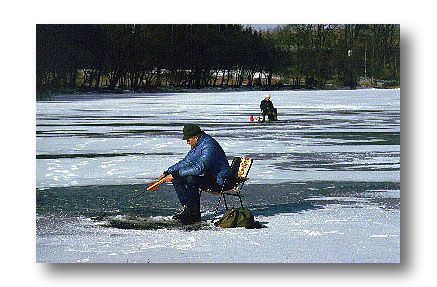|
According to statistics, February is indeed
the coldest month. One moment there are pleasant winds from the
south, the next snowflakes are falling, and the waters are covered
with a thin layer of ice which cannot be penetrated by even the
heaviest fly and the fastest sinking fly line. It can be hard
to accept such a turn when you had just started longing for spring.

- Ice fishing on Ravn
Sø near Silkeborg.
- © photo: Steen
Ulnits
Fortunately, February means the beginning
of a completely new season in the river. If it is sufficiently
cold, shoals of bulging, silvery Greenlanders will have come
up from the sea and fjords to spend the winter - away from the
cold, salty waters that may threaten their lives.
Spawning Cod
February is also the peak season for the
anglers who start chasing the big spawning cod in the Sound with
their stiff rods, heavy lines and heavy jigs. It is a tough job
to keep warm with snowflakes whirling around freezing ears -
usually hidden under a warm fur cap.
Under the tightly packed boats, the spawning
cod are packed just as tightly. It is a kind of mass wedding,
where many cod spawn at the same time. It is questionable whether
it is right to disturb the cod in the middle of spawning, when
they are certainly not interested in food. It is a fact that
almost all the big spawning cod have been wrongly hooked.
Ice fishing
February is also the month that provides
the biggest opportunity for trying ice fishing - something with
is considered quite exotic in this country. This may be one of
the rare few times the ice can bear a man's weight, and for that
it must be at least 10cm thick - preferably 15cm. When that is
the case, get out the old ice drill, if you have got one. Otherwise
you will have to borrow one or invest in one. Experience shows,
by the way, that the best safeguard against future hard winters
is to buy an ice drill!
Once you get through the ice, it is actually
quite funny that a typical warm water fish like the perch is
the quickest deep-frozen catch. It can be difficult to find the
shoals, so it is often necessary to drill several holes before
you get a rise. The periods where you get a rise are usually
quite hectic under the ice but equally very short.
Coastal fishing
Along the coast, February is definitely
the low season. The coastal waters are usually so cold that neither
cod nor sea trout like them. They have therefore moved to deeper
and warmer waters or - in the case of the sea trout - they have
moved into the brackish fjords or maybe even up to the freshwater
rivers to spend the winter.
A quick trip along the coast should head
into brackish fjords instead of open seacoasts here in February.
And in the protected inlets, there is usually always something
to look for.
And if it should become necessary - as
it has so often before in February - to fight your way back to
the car and a little warmth through a heavy snowstorm from the
east, there is no reason for despair. From the end of February,
springtime is just around the corner - with lots of angling possibilities
and a brand new season waiting ahead!
© Steen Ulnits
|

